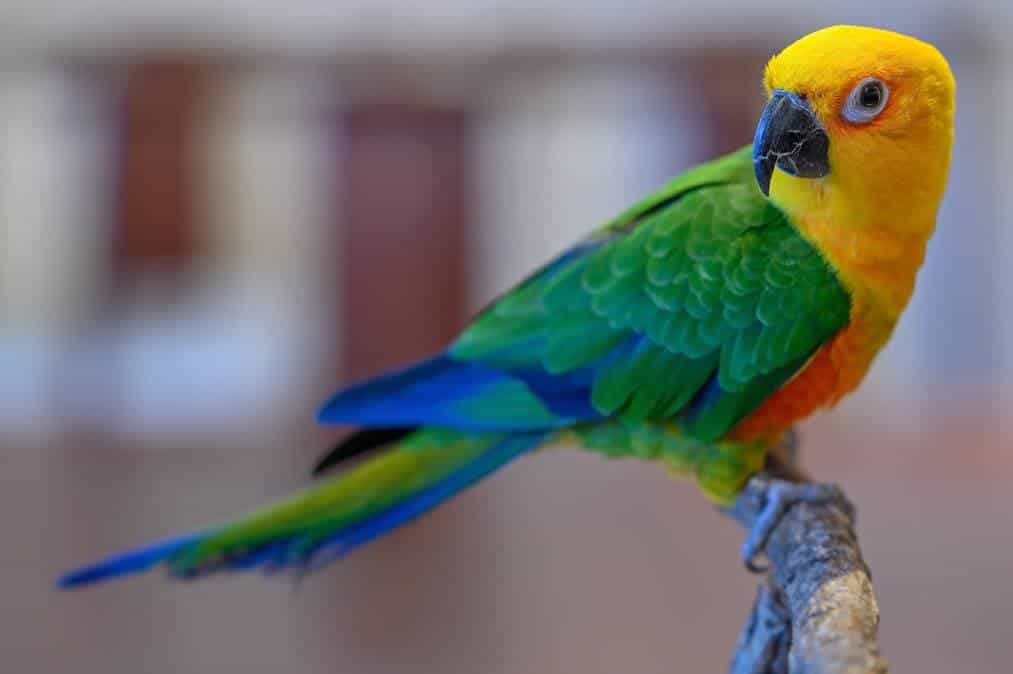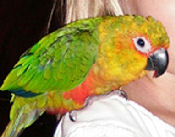The Jenday Conure is quite striking with its beautiful colors. They are closely related to the Sun Conure Aratinga solstitialis and the Golden-capped Conure Aratinga auricapilla. Sometimes there is confusion between the Jenday Conure and the Sun Conure but you can easily identify the Jenday by its green wings and back, while the Sun has mostly yellow wings.
A super sweet bird, the attractive Jenday Conure is very sociable and makes a very tame and loveable companion. They love to “talk”, and yes, they are rather noisy little creatures. Being very active, they enjoy playing with toys, climbing, and chewing. Their antics can be very comical and at the same time they are very affectionate.
If you are looking for a beautiful conure, the Jenday Conure will certainly capture your attention. It is also much less costly than the Golden Conure or the Queen of Bavaria Conure, two conures that are often touted for their beauty.
For more information about the care of Conures see:
Guide to a Happy, Healthy Conure
- Kingdom: Animalia
- Phylum: Chordata
- Class: Aves
- Order: Psittaciformes
- Family: Psittacidae
- Genus: Aratinga
- Species: jandaya
Scientific Name:
Distribution:
These birds are native to northeastern Brazil.
Description:
The Jenday Conure is a small member of the parrot family, and is very colorful. The head and upper breast are a golden yellow that blends into a reddish gold on the lower abdomen. Sometimes they will have an olive yellow breast. The wings, upper tail, and upper back are green moving into an orangish red on the lower back. The underside of the tail is black and the under side of the wings are an orangish red. The tip of the tail and the outer wing feathers are blue. The beak and the feet are black.
A mature Jenday Conure reaches its full coloration at about two years of age. A younger bird will have duller coloration; a paler yellow head and neck with some greens, and a paler red on the breast.
Size – Weight:
The Jenday Conure will get up to 11 4/5″ (30 cm), 4.4 ozs for the male and
5 ozs for the female (125g -142 g).
Care and feeding:
A roomy cage is required unless the bird is to be let out for extended periods. Many birds can spend most of their time on a play pen or parrot perch. They eat a variety of sprouts, seeds, nuts, fruits, vegetables, and commercial pellets, as well as the same nutritional foods humans eat.
See About Conures: Housing and About Conures: Care and Feeding for more information.
Social Behaviors:
They live in pairs or small groups of 10 to 15 birds. They love to play, and can be fairly destructive if not watched. They can also be rather noisy. Despite all this, they make a real fun pet and are very popular.
|
Breeding/Reproduction:
They breed readily if they have the right size aviary. Though these birds will need to be either DNA or surgically sexed for a certain determination, the iris of the female is light brown and they have a grayish white eye ring while the male’s iris is darker and his eye ring is pure white.
The hen lays three to four eggs which are incubated for about 26 days. Both parents will feed the young. The young fledge (leave the nest) after about two months. The ideal nest box size should be 21 1/2″ x 10″ x 11″ (55x25x28 cm), with a 2 3/4″ opening (7 cm) which the parents will chew on and alter it to their liking.
There has been a hybrid conure produced by crossing a Jenday Conure with a Nanday Conure.
Potential Problems:
As with most Aratinga species, this bird can be noisy.
See About Conures: Potential Problems for information on illnesses.
Availability:
This bird is generally available. They can usually be found at pet stores and reputable breeders.
Activities:
Loves to climb and play. Provide lots of toys.
Featured Image Credit: Paul Atkinson, Shutterstock

